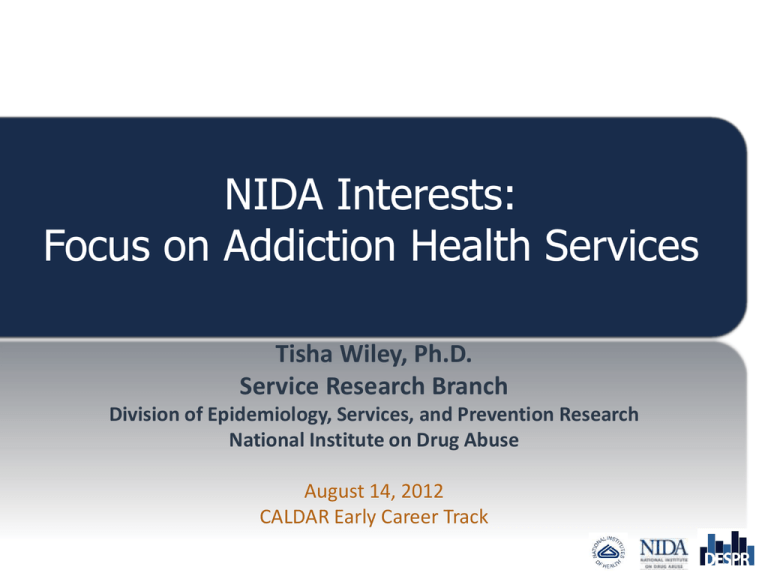
NIDA Interests:
Focus on Addiction Health Services
Tisha Wiley, Ph.D.
Service Research Branch
Division of Epidemiology, Services, and Prevention Research
National Institute on Drug Abuse
August 14, 2012
CALDAR Early Career Track
Division of Epidemiology, Services and Prevention Research (DESPR):
NIDA’s Public Health Division
EPIDEMIOLOGY RESEARCH BRANCH
DESPR promotes
epidemiology, services &
prevention research to
understand and address the
range of problems
related to drug abuse, in order to
improve public health.
PREVENTION RESEARCH BRANCH
SERVICES RESEARCH BRANCH
Division of Epidemiology, Services and Prevention Research (DESPR):
NIDA’s Public Health Division
EPIDEMIOLOGY RESEARCH BRANCH
DESPR promotes
epidemiology, services &
prevention research to
understand and address the
range of problems
related to drug abuse, in order to
improve public health.
PREVENTION RESEARCH BRANCH
SERVICES RESEARCH BRANCH
Service Research Branch Mission
Support rigorous research to improve the quality
of addiction treatment and recovery support
services
SERVICES: Drug, alcohol, nicotine disorder services & HIV/HCV
services for drug-involved individuals
DELIVERY SYSTEMS: Specialty treatment programs, general
health care settings, criminal justice settings, social service
agencies, etc.
QUALITY: effective services for all who need them at
reasonable a cost
• Availability, access, appropriateness, effectiveness, safety,
efficiency, cost
Our Research Vision
NIDA’s Services Research Branch
supports science that leads
addiction treatment services toward
the highest possible levels of
quality, efficiency, & economy.
About NIDA’s Service Research Branch
238 Active Grants (as of
August 2012)
$75m in Direct Costs
83% of funding goes to
Research Project Grants
R01, R21, R03s, etc.
PIPELINE
Services Research Continuum
Defining
service
needs
Refining
practices
for realworld use
Testing
service
delivery
models
Measures/methods
SRB GRANT TOPICS
Co- & Multi-morbidity
Drug use
trajectories
Preimplementation
research
Seek, Test, Treat, Retain
Alternative
service models
Health disparities
CJDATS (U01)
Justice Involved Adolescents (U01)
CJ services
Tx engagement/retention
Implementation
Trials
Primary Care
SBIRT
EBP uptake
Workforce
Use of technology in treatment
Systems Overlap (e.g., child welfare)
Other D&I
Trials
Selected SRB Areas of Interest
Technology & Methodology
Implementation, Sustainability & Outcomes of EBP’s
Special Settings: Criminal Justice, Juvenile Justice, Child Welfare
Healthcare Reform Impact
Methodology & Technology
Relevant Funding Announcements
SRB Flagship PA’s
• PA-12-127 (R01) – 5 years, unlimited*
• PA-12-128 (R21) – 2 years, $275k direct total
• PA-12-129 (R03) – 2 years, $100k direct total
• PA-12-134 (R34) – 3 years, $435 direct total
Technology/HIV PA’s
• PA-12-117 (R01)
• PA-12-118 (R34)
Methodology & Technology
Health Services and Economic Research on the Prevention and Treatment
of Drug, Alcohol, and Tobacco Abuse (R01, R21, & R03)
Our “Flagship” PA’s
PA-12-127 (R01)
PA-12-128 (R21)
PA-12-129 (R03)
Supports “developing, refining, and validating new
approaches for conducting treatment and prevention
services research”
Study Designs
Measurement Tools
Simulation Modeling
Quality/Performance Measures
Statistical Models
Methodology & Technology
Technology-Based Interventions to Promote Engagement in Care and
Treatment Adherence for Substance Abusing Populations with HIV (R01, R34)
Use of technology to directly improve patient-level
outcomes (i.e., adherence)
Capacity of HIV treatment providers and related service
delivery organizations to adopt and integrate such
technologies to promote HIV treatment outcomes;
Use of technology to improve the organization and
delivery of HIV treatment and services.
Implementation Science
Relevant Funding Announcements
SRB Flagship PA’s, especially R34
RFA-DA-13-001 (R21/R33)
• (August 22 Deadline)
Implementation Science
PA-12-130 (R34): Building System Capacity for
Implementing EBPs
Organizational and/or systems-level interventions that
may optimize access, utilization, delivery, quality, and/or
cost of treatment services through the use of EPBs
Organizational and/or systems-specific adaptations to
existing EBPs
Novel service delivery models to be pilot tested in
preparation for larger-scale effectiveness trials
Implementation Science
PA-12-130 (R34): Building System Capacity for
Implementing EBPs
Hypothesis-driven research that:
• Addresses systems-level implementation research questions
• Builds provider/funder capacity for conducting research beyond life of
the grant
Designed to implement (not develop) evidence-based drug
treatment or prevention practices
Ideally, projects will involve:
• One or more treatment or prevention settings
• An external agency that impacts their services (e.g., SSA, SMA)
• An academic partner experienced in doing NIH research
Implementation Science
Implementation science is
not intended to test interventions,
but to study how
to get evidence-based interventions
adopted, adapted, & sustained.
Implementation Research:
Studying the Technology Transfer Process
How do we move EBP’s into everyday use?
How do we organize treatment to support EBPs?
How do we train and supervise staff to use EBPs?
How do we change business practices to value EBPs?
Client-level outcomes are NOT the focal outcome.
Research questions are about finding effective implementation
strategies.
What are implementation strategies?
STRATEGIC
PLANNING
Determining organization’s needs and alternative solutions
READINESS
ASSESSMENT
Determining organization’s readiness for change
PROCESS
IMPROVEMENT
Monitoring and modifying organizational processes and procedures
to implement and sustain new practices (e.g., NIATx)
TRAINING AND
SUPERVISION
Who is trained (e.g., clinical staff, correctional staff, administrative
staff), on what, and required resources?
INFORMATION
SYSTEMS
Modifying what information is collected, how it is accessed and
used to support decision-making.
ORGANIZATIONAL
CULTURE
How can organizational culture be changed to support the
infrastructure needed to maintain new services?
Special Settings:
Criminal Justice, Juvenile Justice, & Child Welfare
Relevant Funding Announcements
Flagship PA
TRIALS (RFA-DA-13-009)
• Deadline: November 28, 2012
Relevant Funded Projects
CJ-DATS (U01, 10 Research Centers)
Seek, Test & Treat: Addressing HIV in the Criminal Justice
System (R01s, 13 awards)
• Data Harmonization
Special Settings:
Criminal Justice, Juvenile Justice, & Child Welfare
RFA-DA-13-009 (U01): Translational Research on Interventions for
Adolescents in the Legal System: TRIALS
Purpose
Test implementation strategies and associated measures to
improve the continuum of substance abuse prevention and
treatment services delivered to youth under juvenile justice
supervision
Structure
Multisite collaborative Agreement
Two Types of Applications
Coordinating Center
Research Center
Special Settings:
Criminal Justice, Juvenile Justice, & Child Welfare
RFA-DA-13-009 (U01): Translational Research on Interventions for
Adolescents in the Legal System: TRIALS
Need
Youth and adolescents in juvenile justice system at high risk and
need effective drug use prevention and treatment services
Most juvenile justice systems do not provide adequate services
Opportunity
We have effective, evidence-based prevention and treatment
interventions for adolescents
Involvement in the juvenile justice system provides window to
intervene with drug abuse & HIV
Researchers can partner with juvenile justice agencies:
• Adolescent drug courts; truancy, teen, family courts
• Juvenile detention
• Juvenile probation
Special Settings:
Criminal Justice, Juvenile Justice, & Child Welfare
Key Features of CJ-DATS-2 (2008-2013)
Focus on implementation research
Transfer of evidence-based practices
Criminal justice re-entry-systems improvement
Correctional Facilities, Probation, & Parole
Test of different implementation & quality improvement
strategies
Special Settings:
Criminal Justice, Juvenile Justice, & Child Welfare
Key Features of CJ-DATS-2 (2008-2013)
3 Research Protocols
10 Research Centers
62 Correctional Facilities
11 States
2 NIDA FTEs
$26.8 million over 5 years
$2.7 million from CSAT and DOJ co-funders
Special Settings:
Criminal Justice, Juvenile Justice, & Child Welfare
Key Features of CJ-DATS-2 (2008-2013)
MAT
Does strategic planning intervention + staff training improve
MAT utilization?
HIV
Does a local change team improve utilization of HIV services
along the continuum of care?
Assessment
Does a local change team improve the case planning process?
Criminal Justice System:
Key Participants and Intervention Opportunities
ENTRY
PROSECUTION
ADJUDICATION SENTENCING
(Arrest)
(Court, Pre-Trial
Release, Jail)
(Trial)
(Fines, Community
Supervision,
Incarceration)
CORRECTIONS
(Probation, Jail,
Prison)
COMMUNITY
REENTRY
(Probation, Parole,
Release)
Key Participants/Stakeholders
Crime victim
Police
FBI
Crime victim
Police
FBI
Judge
Prosecutor
Judge
Defense Attorney Jury
Defendant
Jury
Judge
Probation
Officers
Correctional
Personnel
Probation/
Parole Officers
Family
Communitybased providers
Drug Treatment
Drug Treatment
Aftercare
Housing
Employment
Mental Health
Half-way House
TASC
Intervention Opportunities
Screening/
Referral
Diversion
Programs
Drug Courts
Community
Treatment
TASC
N/A
Drug Court
Terms of
Incarceration
Release
Conditions
Healthcare Reform Impact
Relevant ACA Provisions &
Environment:
Expands coverage to more than 30
million individuals, many at high risk
for drug abuse
Fundamentally changes the way
many drug abuse prevention and
treatment services are financed
Emphasizes central role of primary
care settings
Focuses on screening and prevention
Promotes use of electronic health
records
Healthcare Reform Impact
Relevant RFA: RFA-DA-13-001 (R21/R33)
Closes August 22, but still an area of interest
Research Topic Examples:
Uptake rate for insurance among those with drug use
disorders and related conditions and how this is affected by
outreach and types of offered coverage
Responsiveness of demand for services among the newly
covered
• Effect on types and quantity of services sought and responses by
payers
Effect on financing and cost of treatment
Other FOAs
Time-Sensitive Drug Abuse Research (R01) PAR-10-072
“Rapidly evolving areas where opportunities for
empirical study are, by their very nature, only available
through expedited review and award of support.”
3 Criteria
scientific value and feasibility are clear,
rapid review and funding are required
knowledge gained from the study is time-sensitive –regular
review cycle = missed opportunity
Other FOAs
Drug Abuse Dissertation Research (R36) PAR-10-020
Last receipt date: October 2012
2 years, $50k in direct costs
Supports research on:
Epidemiology
Prevention
Services
Women and Sex/Gender Differences
Other Areas of Interest
Clinical Quality Improvement
Adaptive service delivery strategies to adjust level,
dosage, and type of intervention in response to changing
needs
Continuity of care within and across settings
Integrated addiction and other medical treatment
Performance measurement and management
Impact of IT systems and system changes
Other Areas of Interest
Services Organization and Management
Service delivery models (e.g. collaboration, co-location)
Management and human resources (e.g. recruitment,
training, retention)
Business practices
Other Areas of Interest
Economics
Financing, e.g.
Effect of health insurance on demand for treatment
Effect of reimbursement mechanisms on supply of treatment
Economic incentives for quality improvement
Economic evaluation (CEA, CUA, CBA)
Economic efficiency
SRB: We are here to help!
Contact Us: (301) 443-6504
Redonna Chandler, Ph.D.
• Branch Chief
Richard Denisco, M.D.
• Medication-assisted treatment, SBIRT, NIDA-MED
Lori Ducharme, Ph.D.
• Organization & management, implementation science
Sarah Duffy, Ph.D.
Dionne Jones, Ph.D.
Shoshana Kahana, Ph.D.
Tisha Wiley, Ph.D.
(tisha.wiley@nih.gov)
• Economics research, performance measurement
• HIV, vulnerable populations
• HIV prevention & adherence, child & adolescent drug treatment
• Science Officer for CJDATS; criminal justice research, methodology








